Abstract
AIM: To study the preparation and cleavage activity of HpRz directed against the transcript of HBV core gene in vitro.
METHODS: HpRz gene designed by computer targeting the transcript of HBV core gene was cloned into the vector p1.5 between 5’-cis-Rz and 3’-cis-Rz. 32p-labeled HpRz transcript proved whether the vector fit for the preparation of hairpin ribozyme in vitro. 32p-labeled pKC transcript containing HBV core region as target-RNA was transcribed using T7 RNA polymerase and purified by denaturing PAGE. Cold HpRz transcript was incubated with 32p-labeled target-RNAs under different conditions and radio autographed after denaturing polyacrylamide gel electrophoresis.
RESULTS: HpRz has the specific ability of cleavage of target RNA at 37 °C and 12 mM MgCl2. Km = 26.31 nmol/L, Kcat = 0.18/min. These results revealed that the design of HpRz was correct.
CONCLUSION: HpRz prepared in this study possesses specific catalytic activity from the identification of cleavage activity. These results indicate that hairpin ribozyme may intracellularly inhibit the replication of HBV, therefore it may become a novel potent weapon for the treatment of hepatitis B.
INTRODUCTION
Hepatitis B is a major worldwide health problem[1-5]. Hepatitis B virus is a small hepatotropic DNA virus, causing acute and chronic B-type hepatitis in man. Chronic infection is associated with a high risk of liver cirrhosis and primary liver carcinoma[6-14]. Currently available therapies are of limited efficacy[15-33]. Ribozyme is a kind of catalytic RNA which can catalyze the cleavage of sequence-specific RNA. Compared with antisense RNA, ribozyme may be a more effective experimental tool to suppress the gene expression. Possessing both antisense and RNA cleavage activity, the enzymatic nature of ribozyme may facilitate effectiveness even at low level of expression[34]. Hepatitis B virus is a DNA virus that replicates through reverse transcription of a RNA intermediate (pregomic RNA). So engineered anti-HBV ribozyme can potentially be multifunctional, targeting pregenomic RNA and viral mRNA to suppress the replication of hepatitis B virus. Since previous attempt to use hammerhead ribozyme for the intracellular inhibition of HBV replication have been largely unsuccessful in intact cell[35,36], however engineered hairpin ribozymes have been shown to inhibit replication of human immunodeficiency virus, hepatitis C virus and human papilloma virus in vivo[37-44]. So we designed hairpin ribozyme to inhibit HBV replication. It is well known that HBV C region is associated with viral replication. In this report we have designed hairpin ribozyme targeting core gene of HBV by computer, prepared hairpin ribozyme by transcription of recombinant plasmid in vitro, and proved its ability to cleave HBV in vitro from identification of activity of anti-HBV hairpin ribozyme.
MATERIALS AND METHODS
Materials
E. coli DH5α has been maintained in our laboratory. The ribozyme vector p1.5 (kind gift of Qi GR, Shanghai Institute of Biochemistry), Plasmid pKC[45] for target-RNAs (constructed by Dr Lian JQ, the Forth Military Medical University) has been maintained in our laboratory. DNA sequence Kit, in vitro transcription kit, restriction endonucleases, T4 DNA ligase, RNase A free DNase I were purchased from Promega Company; and RNase inhibitor, T4 DNA polymerase from Takara Company, α32p dATP and α32 UTP from Beijing Yahui Company, Materials were used all of analytical purification.
Oligonucletides of HpRz: R1 5’-CTAGATCCGGAAGAACTAAACCAGAGAAACAGATCTCTTCGGAGATCGTACATTACCTGGTAGGTAC-3’; R25’-CTACCAGGTAATGTACGATCTCCGAAGAGATCTGTTTCTCTGGTTTAGTTCTTCCGGAT-3’. They were chemically synthesized in Beckman Oligo-1000 DNA synthesizer.
Methods
In vitro transcription and purification of target RNA The template PKC was linearized with BstXI, the 3’-overhangs of linearized pKC was blunted with T4 DNA polymerase. in vitro transcription was carried out at 37 °C for 90 min in a 20 ìL final volume containing 40 mmol·L-1 Tris·HCl (pH 7.5),50 mmol·L-1 DTT, 2 mmol·L-1 spermidine,8 mmol·L-1MgCl2, 0.25 mmol·L-1ATP, GTP,CTP, 0.05 mmol·L-1UTP,370 KBq alpha 32p-UTP,80 U T7 RNA polymerase and 4 μg linearlized template. Target RNA was purified by 60 g·L-1 denaturing gel electrophoresis by cutting off the autoradiograph bands. Labeled target RNA was dissolved in DEPC H2O and reserved under -20 °C.
Construction of recombinant plasmid for ribozyme and preparation of ribozyme in vitro The hairpin ribozyme HpRz for HBV was designed according to the computer software pcFOLD combiled by Professor Zuker (Canadian Academy of Science). The homologous possibility with the gene of human being was excluded by consulting with RNA sequence of human cell from NCBI Genbank. Synthesized ribozyme fragments were cloned into XbaI/KpnI sites of p1.5 as pHpRz. Recombinant plasmid was identified by being digested with EcoRI and HindIII, then the DNA sequence of recombinant plasmid was analyzed through the dideoxy method developed by Sanger(Figure 1). The template pHpRz was linearized with EcoRI and in vitro transcription and purification of ribozyme were the same as those of target RNA. To get a large amount of transcribed HpRz without isotope, the transcription of HpRz was set up according to manufacture’s instruction, then template was digested with RNAse A free DNase I, the RNA was dissolved in DEPC H2O and measured by spectrophotomer containing 3’-cis-Rz and 5’-cis-Rz.
Figure 1.
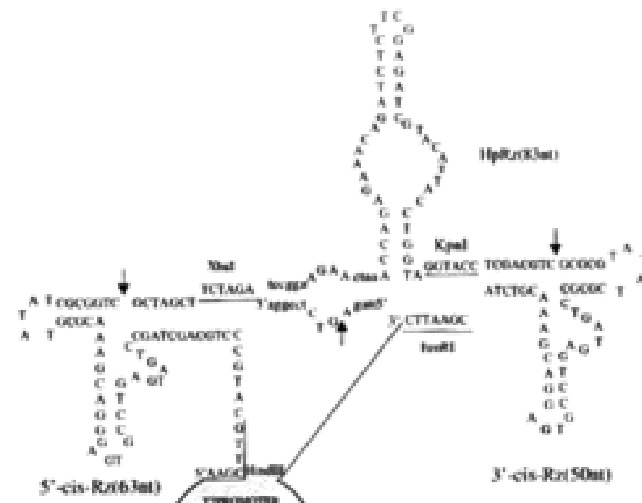
Structure of HpRz plus 5’-cis-Rz and 3’-cis-Rz.
In vitro cleavage reaction of HpRz The cold hairpin ribozyme and target RNA labeled by alpha-32p UTP were quantified. The cleavage reaction of ribozyme was performed in ribozyme buffer (40 mmol·L-1 Tris·HCl pH7.5/ 12 mmol·L-1 MgCl2 ) at 37 °C with 10 nmol·L-1 32p-labeled substrate and 10 nmol·L-1 cold ribozyme. In this condition the cleavage mixture was incubated at different time points.The volume of the reaction is 5 μL. 1 μL loading buffer (2.5 g·L-1 Bromophenol Blue, 2.5 g·L-1Xylene cyanol FF, 20 mmol·L-1 EDTA and saturated Urea) was added to stop the reaction. The result could be analyzed after running a 60 g·L-1 denaturing polyacylamide gel electrophoresis. The cleavage efficiency was calculated from Bq values of the bands of substrate (S) and products (P) CE = [P / (P + S)]·100%.
Kinetics of the cleavage reaction The procedure was described by Uhlenbeck[46].The cleavage reactions were done and the results were analyzed as above. Km and Kcat were calculated by Lineweaver-Burk method (double- riciprocal plot).
RESULTS
Identification of recombinant plasmid pHpRz
The result of digested recombinant plasmid by EcoRI and HindIII was analyzed by running 20 g·L-1 agrose gel elrctropheries(Figure 2).This result and the DNA sequence analysis showed that the clone was correct.
Figure 2.
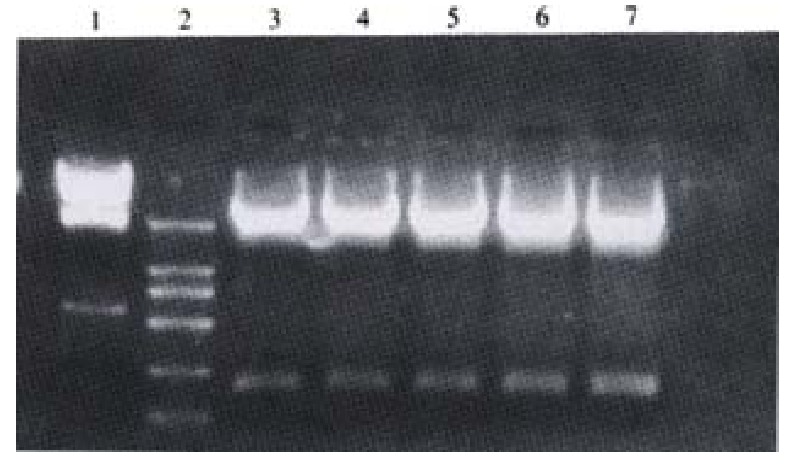
The analysis of HpRz digested by EcoRI and HindIII(20 g·L-1 agrose gel). lane 1:λ DNA/HindIII marker; lane 2: DL2000 DNA marker; lane 3-7: HpRz digested by EcoRI and HindIII.
Identification of transcription of ribozyme
The transcription of ribozyme from EcoRI-linearized template should include three bands: 50 nt, 63 nt and 83 nt. The resultshowed our design was correct (Figure 3).
Figure 3.
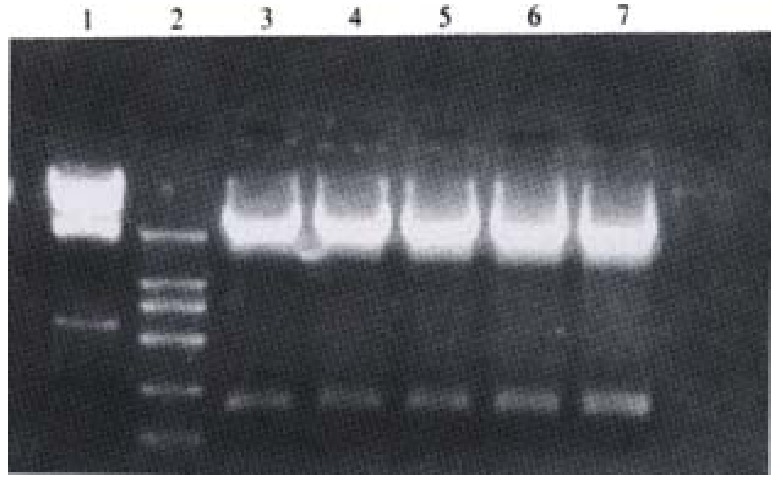
in vitro transcript of pHpRZ. HpRz is 83nt. 5’-cis-Rz is 63nt, 3’-cis-Rz is 50nt.
In vitro cleavage reaction of ribozyme and kinetics of the cleavage reaction
Time course The cleavage mixture ( Rz :substrate = 1:1 mol·L-1) were incubated at 37 °C for different time points,it was shown that the reaction product increased with the increase in incubation time and within 60 min it was linear, CE = 32.67% (Figures 4 and 5).
Figure 4.
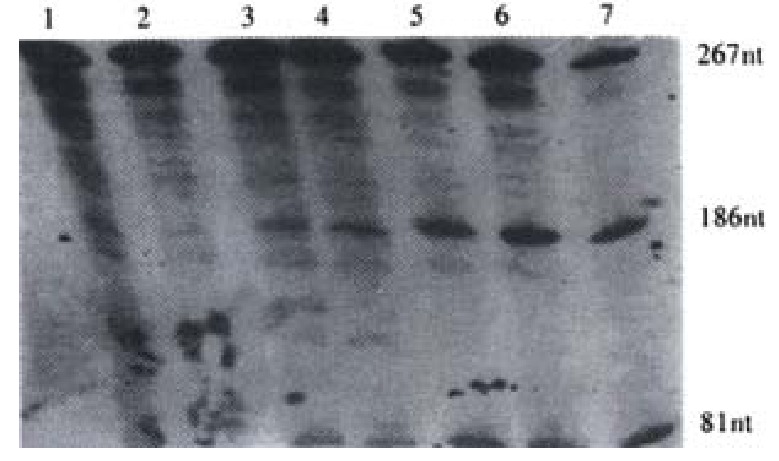
Time course. Specific cleavage of HBV RNA target molecules by HpRz in vitro. Lane 1:substrate control; lane 2:incubated for 6 min; lane 3: 10 min; lane 4:20 min; lane 5:40 min; lane 6:60 min; lane 7:90 min.
Figure 5.
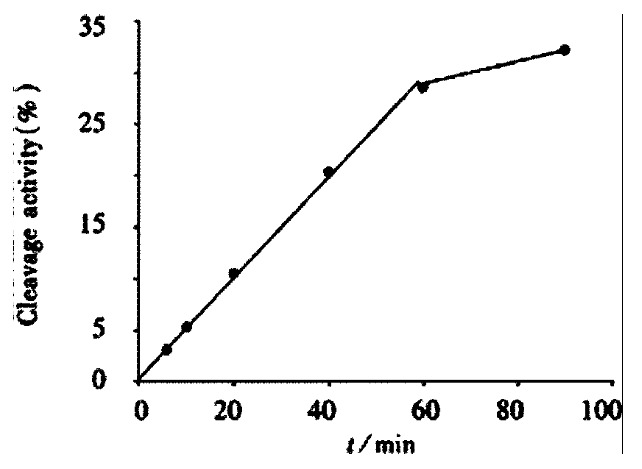
Time curves of cleavage reactions of HpRz prepared in vitro.
The kinetics of cleavage reaction Under the condition of 37 °C and 40-minute reaction time, the cleavage efficiency was calculated at Rz:S = 1:1,1:2,1:4,1:8 and 1:16(mol/L)ratio. Km and Kcat were obtained by the Lineweaver-Burke method (Figure 6) Km = 26.31 nmol·L-1, Kcat = 0.18·min-1.
Figure 6.
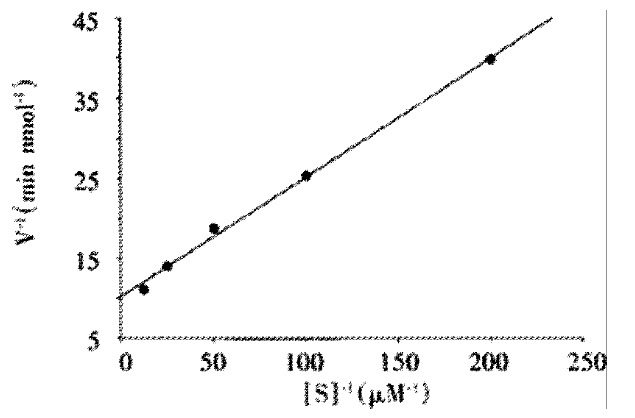
Lineweaver-burk kinetic plots of the specific cleavage of HBV RNA target molecules by HpRz prepared in vitro. HpRz concentration is 5 nmol·-1, substate concentration is 80,40,20,10 5 nmol·L-1. Reaction is at 37 °C for 40 min.
DISCUSSION
Ribozyme is classified into six kinds. Hammerhead ribozyme and hairpin ribozyme have been studied extensively as experimental tools for trans suppression of gene expression and possible therapeutic application. Hammerhead ribozyme is small and easy to design and there is less restriction of selection of target site, so its application is extensive. Although hammerhead ribozyme was used to suppress HBV replication, and hammerhead ribozyme-mediated cleavage of target RNA could be achieved in vitro and in cell extract, they showed poor effect in intact cells[35,36]. Cellular protein and low Mg2+ concentration limited intracellular ribozyme activity. It will be difficult to raise the intracellular Mg2+ level. Protein can influence the ribozyme intracellular performance. However, cellular protein may also have positive effect on ribozyme-mediated catalysis. Because of limited knowledge on mechanisms of protein modulation of catalytic RNA activity and the complex formed by ribozyme and ribonucleoprotein are frequently large, poorly defined and difficult to study, it is hard for us to use protein to enhance ribozyme activity. Compared with hammerhead ribozyme, hairpin ribozyme has complex structure, hard to design and there is too much restriction of target site and its application is limited. It possesses the better cleavage activity under physiological condition from in vitro assays done under standard condition at 37 °C and low Mg2+ concentration. PJ Welch[47] designed three hairpin ribozymes against the pgRNA (pregomic RNA) encoding HBV surface antigen, the polymerase and the X protein and demonstrated that two of them can cleave target RNA in vitro and reduced the level of HBV expression and suppressed HBV replication in vivo. Zu et al[48] used hairpin ribozyme library to identify accessible target sites within HBV progenomic RNA, four hairpin ribozyme targeting conserved region in subtypes of HBV can inhibit HBV replication in intact cell. Until now no report on hairpin ribozyme directed against core gene of HBV has available. In this report we have designed and constructed hairpin ribozyme to cleave transcripts of HBV core gene in vitro. Our experiment was the study of preparation and cleavage activity of hairpin ribozyme-HpRz by means of the computer design, cloning the ribozyme gene into the vector that possessed cis-cleavage ribozymes and labeled it with isotope. The in vitro transcription effect of ribozyme was satisfactory, 5’-cis-Rz and 3’-cis-Rz cut themselves and released the purposed ribozyme. The ribozyme flanking sequences could be shortened and ribozyme structure induced by the secondary structure of long flanking sequences would be eliminated. That would affect ribozyme turnover ratio/binding activity in the result of an accurate hybridization and better cleavage for ribozyme. Moreover isolation of ribozyme is very convenient by cutting off autoradiograph bands. Ribozyme is quantified more accurately.In this paper the number of nucleotide of hairpin ribozyme was similar to that of the cleavage product, so we can not use transcribed HpRz labeled by isotope. The ribozyme vector was proved to fit for preparation of hammerhead ribozyme[49-51], In our study we also used the preparation of hairpin ribozyme and its efficacy is similar to that of hammerhead ribozyme. So the vector possesses wide applicability in the study of preparation of ribozyme in vitro, not only hammerhead ribozyme, but also hairpin ribozyme.
HBV is a double-stranded DNA virus replicates through pregenomic RNA intermediate, which provides a therapeutic opportunity for a novel antiviral gene therapy based on ribozyme RNA cleavage. In our experiment, we have designed and constructed hairpin ribozyme directed against HBV core region. The kinetics of hairpin ribozyme showed that HpRz possessed specific ability of cleaving the HBV transcripts in vitro. These results indicated that HpRz is worthy of being further studied in intact cells and developed as a nucleic acid drug in the future. However the in vitro result can not completely reflect in vivo performance. The total HBV mRNA transcript in cell forms the secondary and tertiary structure which affect ribozyme combination with the substrate and cleavage activity. The subcellular compartment where the ribozyme is located, degradation of ribozyme, the complexes which are formed by ribozyme and ribonucleoprotein within cell and gene delivery system, affect the combination with substrate and cleavage of ribozyme. So in vivo effect of the ribozyme should be investigated as soon as possible. The ribozyme fragments would be cloned into eucaryotic vectors and transfected into HepG2 cell or Huh7 cell. Experimental analysis of the anti-HBV ribozyme activity in vivo is in progress and should help determine its potential use as antiviral agents against HBV.
Footnotes
Supported by Ministry of Health (No 98-1-140) and Chinese Academy of Sciences (No KJ951-B1-610)
Edited by Ma JY
References
- 1.Shi H, Wang FS. Host factors in chronicity of hepatitis B virus infection and their significances in clinic. Shijie Huaren Xiaohua Zaizhi. 2001;9:66–69. [Google Scholar]
- 2.Befeler AS, Di Bisceglie AM. Hepatitis B. Infect Dis Clin North Am. 2000;14:617–632. doi: 10.1016/s0891-5520(05)70124-0. [DOI] [PubMed] [Google Scholar]
- 3.Maddrey WC. Hepatitis B: an important public health issue. J Med Virol. 2000;61:362–366. doi: 10.1002/1096-9071(200007)61:3<362::aid-jmv14>3.0.co;2-i. [DOI] [PubMed] [Google Scholar]
- 4.Lau GK. Hepatitis B infection in China. Clin Liver Dis. 2001;5:361–379. doi: 10.1016/s1089-3261(05)70170-7. [DOI] [PubMed] [Google Scholar]
- 5.Merican I, Guan R, Amarapuka D, Alexander MJ, Chutaputti A, Chien RN, Hasnian SS, Leung N, Lesmana L, Phiet PH, et al. Chronic hepatitis B virus infection in Asian countries. J Gastroenterol Hepatol. 2000;15:1356–1361. doi: 10.1046/j.1440-1746.2000.0150121356.x. [DOI] [PubMed] [Google Scholar]
- 6.Guo SP, Wang WL, Zhai YQ, Zhao YL. Expression of nuclear factor-kappa B in hepatocellular carcinoma and its relation with the X protein of hepatitis B virus. World J Gastroenterol. 2001;7:340–344. doi: 10.3748/wjg.v7.i3.340. [DOI] [PMC free article] [PubMed] [Google Scholar]
- 7.Shi DR, Lu L, Wang JH, Dong CL, Cong WT. HBV DNA distibution of hepatitis B virus in pancreas and liver of patients with cirrhosis. Shijie Huaren Xiaohua Zazhi. 2000;8:751–754. [Google Scholar]
- 8.Wu C, Cheng ML, Ding YS, Liu RC, Li J, Wang WL, Hu L. A five - year fellow up survey of risk factor of viral hepatic cirrhosis. Shijie Huaren Xiaohua Zazhi. 2000;8:1365–1367. [Google Scholar]
- 9.Wang HY, Yan RQ, Long JB, Wu QL. Cyclin D1 amplification is associated with HBV DNA intergration and pathology in human hepatocellular carcinoma. Shijie Huaren Xiaohua Zazhi. 1999;7:98–100. [Google Scholar]
- 10.Fang ZR, Yang DH, Qin HR, Hua CZ, Xu Z, Qiu HL. Expression of IGF-I, IGF-I receptor mRNA in hepatocellular carcinomas and adjacent nontumor tissue. Shijie Huaren Xiaohua Zazhi. 1999;7:848–850. [Google Scholar]
- 11.Yan JC, Ma Y, Chen WB, Shun XH. Pathological significance of expression intrahepatic smooth muscle fiber in hepatitis B. Shijie Huaren Xiaohua Zazhi. 2000;8:1242–1246. [Google Scholar]
- 12.Zhai SH, Liu JB, Liu YM, Zhang LL, Du ZH. Expression of HBsAg, HCV-Ag and AFP in liver cirrhosis and hepatocarcinoma. Shijie Huaren Xiaohua Zazhi. 2000;8:524–527. [Google Scholar]
- 13.Feitelson MA. Hepatitis B virus in hepatocarcinogenesis. J Cell Physiol. 1999;181:188–202. doi: 10.1002/(SICI)1097-4652(199911)181:2<188::AID-JCP2>3.0.CO;2-7. [DOI] [PubMed] [Google Scholar]
- 14.Arbuthnot P, Kew M. Hepatitis B virus and hepatocellular carcinoma. Int J Exp Pathol. 2001;82:77–100. doi: 10.1111/j.1365-2613.2001.iep0082-0077-x. [DOI] [PMC free article] [PubMed] [Google Scholar]
- 15.Zhuang L, You J, Tang BZ, Ding SY, Yan KH, Peng D, Zhang YM, Zhang L. Preliminary results of Thymosin-a1 versus interferon-alpha-treatment in patients with HBeAg negative and serum HBV DNA positive chronic hepatitis B. World J Gastroenterol. 2001;7:407–410. doi: 10.3748/wjg.v7.i3.407. [DOI] [PMC free article] [PubMed] [Google Scholar]
- 16.Xie Q, Guo Q, Zhou XQ, Gu RY. Effect of adenine arabinoside monophosphate coupled to lactosaminated human serum albumin on duck hepatitis B virus. Shijie Huaren Xiaohua Zazhi. 1999;7:125–126. [Google Scholar]
- 17.Li J, Tang B. Effect on replication of hepatitis B virus by Chinese traditional medicine. Shijie Huaren Xiaohua Zazhi. 2000;8:945–946. [Google Scholar]
- 18.Zhu Y, Wang YL, Shi L. Clinical analysis of the efficacy of interferon alpha treatment of hepatitis. World J Gastroenterol. 1998;4:85–86. [Google Scholar]
- 19.Xu KC, Wei BH, Yao XX, Zhang WD. Recently therapy for chronic hepatitis B virus by combined traditional Chinese and Western medicine. Shijie Huaren Xiaohua Zaizhi. 1999;7:970–974. [Google Scholar]
- 20.Zoulim F, Trepo C. New antiviral agents for the therapy of chronic hepatitis B virus infection. Intervirology. 1999;42:125–144. doi: 10.1159/000024972. [DOI] [PubMed] [Google Scholar]
- 21.Lau GK. Use of immunomodulatory therapy (other than interferon) for the treatment of chronic hepatitis B virus infection. J Gastroenterol Hepatol. 2000;15 Suppl:E46–E52. doi: 10.1046/j.1440-1746.2000.02102.x. [DOI] [PubMed] [Google Scholar]
- 22.Guan R. Interferon monotherapy in chronic hepatitis B. J Gastroenterol Hepatol. 2000;15 Suppl:E34–E40. doi: 10.1046/j.1440-1746.2000.02101.x. [DOI] [PubMed] [Google Scholar]
- 23.Torresi J, Locarnini S. Antiviral chemotherapy for the treatment of hepatitis B virus infections. Gastroenterology. 2000;118:S83–103. doi: 10.1016/s0016-5085(00)70008-4. [DOI] [PubMed] [Google Scholar]
- 24.Schiff ER. Lamivudine for hepatitis B in clinical practice. J Med Virol. 2000;61:386–391. doi: 10.1002/1096-9071(200007)61:3<386::aid-jmv18>3.0.co;2-x. [DOI] [PubMed] [Google Scholar]
- 25.Farrell G. Hepatitis B e antigen seroconversion: effects of lamivudine alone or in combination with interferon alpha. J Med Virol. 2000;61:374–379. doi: 10.1002/1096-9071(200007)61:3<374::aid-jmv16>3.0.co;2-7. [DOI] [PubMed] [Google Scholar]
- 26.Lai CL, Yuen MF. Profound suppression of hepatitis B virus replication with lamivudine. J Med Virol. 2000;61:367–373. doi: 10.1002/1096-9071(200007)61:3<367::aid-jmv15>3.0.co;2-a. [DOI] [PubMed] [Google Scholar]
- 27.Jarvis B, Faulds D. Lamivudine. A review of its therapeutic potential in chronic hepatitis B. Drugs. 1999;58:101–141. doi: 10.2165/00003495-199958010-00015. [DOI] [PubMed] [Google Scholar]
- 28.Malik AH, Lee WM. Chronic hepatitis B virus infection: treatment strategies for the next millennium. Ann Intern Med. 2000;132:723–731. doi: 10.7326/0003-4819-132-9-200005020-00007. [DOI] [PubMed] [Google Scholar]
- 29.Lok AS. Hepatitis B infection: pathogenesis and management. J Hepatol. 2000;32:89–97. doi: 10.1016/s0168-8278(00)80418-3. [DOI] [PubMed] [Google Scholar]
- 30.Liu J, McIntosh H, Lin H. Chinese medicinal herbs for chronic hepatitis B: a systematic review. Liver. 2001;21:280–286. doi: 10.1034/j.1600-0676.2001.021004280.x. [DOI] [PubMed] [Google Scholar]
- 31.Doo E, Liang TJ. Molecular anatomy and pathophysiologic implications of drug resistance in hepatitis B virus infection. Gastroenterology. 2001;120:1000–1008. doi: 10.1053/gast.2001.22454. [DOI] [PubMed] [Google Scholar]
- 32.Farrell GC. Clinical potential of emerging new agents in hepatitis B. Drugs. 2000;60:701–710. doi: 10.2165/00003495-200060040-00001. [DOI] [PubMed] [Google Scholar]
- 33.Shaw T, Locarnini S. Combination chemotherapy for hepatitis B virus: the path forward. Drugs. 2000;60:517–531. doi: 10.2165/00003495-200060030-00001. [DOI] [PubMed] [Google Scholar]
- 34.Muotri AR, da Veiga Pereira L, dos Reis Vasques L, Menck CF. Ribozymes and the anti-gene therapy: how a catalytic RNA can be used to inhibit gene function. Gene. 1999;237:303–310. doi: 10.1016/s0378-1119(99)00334-0. [DOI] [PubMed] [Google Scholar]
- 35.von Weizsäcker F, Blum HE, Wands JR. Cleavage of hepatitis B virus RNA by three ribozymes transcribed from a single DNA template. Biochem Biophys Res Commun. 1992;189:743–748. doi: 10.1016/0006-291x(92)92264-x. [DOI] [PubMed] [Google Scholar]
- 36.Beck J, Nassal M. Efficient hammerhead ribozyme-mediated cleavage of the structured hepatitis B virus encapsidation signal in vitro and in cell extracts, but not in intact cells. Nucleic Acids Res. 1995;23:4954–4962. doi: 10.1093/nar/23.24.4954. [DOI] [PMC free article] [PubMed] [Google Scholar]
- 37.Feng Y, Leavitt M, Tritz R, Duarte E, Kang D, Mamounas M, Gilles P, Wong-Staal F, Kennedy S, Merson J, et al. Inhibition of CCR5-dependent HIV-1 infection by hairpin ribozyme gene therapy against CC-chemokine receptor 5. Virology. 2000;276:271–278. doi: 10.1006/viro.2000.0536. [DOI] [PubMed] [Google Scholar]
- 38.Klebba C, Ottmann OG, Scherr M, Pape M, Engels JW, Grez M, Hoelzer D, Klein SA. Retrovirally expressed anti-HIV ribozymes confer a selective survival advantage on CD4+ T cells in vitro. Gene Ther. 2000;7:408–416. doi: 10.1038/sj.gt.3301094. [DOI] [PubMed] [Google Scholar]
- 39.Andäng M, Hinkula J, Hotchkiss G, Larsson S, Britton S, Wong-Staal F, Wahren B, Ahrlund-Richter L. Dose-response resistance to HIV-1/MuLV pseudotype virus ex vivo in a hairpin ribozyme transgenic mouse model. Proc Natl Acad Sci USA. 1999;96:12749–12753. doi: 10.1073/pnas.96.22.12749. [DOI] [PMC free article] [PubMed] [Google Scholar]
- 40.Pérez-Ruiz M, Sievers D, García-López PA, Berzal-Herranz A. The antisense sequence of the HIV-1 TAR stem-loop structure covalently linked to the hairpin ribozyme enhances its catalytic activity against two artificial substrates. Antisense Nucleic Acid Drug Dev. 1999;9:33–42. doi: 10.1089/oli.1.1999.9.33. [DOI] [PubMed] [Google Scholar]
- 41.Koizumi M, Ozawa Y, Yagi R, Nishigaki T, Kaneko M, Oka S, Kimura S, Iwamoto A, Komatsu Y, Ohtsuka E. Design and anti-HIV-1 activity of hammerhead and hairpin ribozymes containing a stable loop. Nucleosides Nucleotides. 1998;17:207–218. doi: 10.1080/07328319808005170. [DOI] [PubMed] [Google Scholar]
- 42.Li X, Gervaix A, Kang D, Law P, Spector SA, Ho AD, Wong-Staal F. Gene therapy targeting cord blood-derived CD34+ cells from HIV-exposed infants: preclinical studies. Gene Ther. 1998;5:233–239. doi: 10.1038/sj.gt.3300582. [DOI] [PubMed] [Google Scholar]
- 43.Welch PJ, Tritz R, Yei S, Leavitt M, Yu M, Barber J. A potential therapeutic application of hairpin ribozymes: in vitro and in vivo studies of gene therapy for hepatitis C virus infection. Gene Ther. 1996;3:994–1001. [PubMed] [Google Scholar]
- 44.Alvarez-Salas LM, Cullinan AE, Siwkowski A, Hampel A, DiPaolo JA. Inhibition of HPV-16 E6/E7 immortalization of normal keratinocytes by hairpin ribozymes. Proc Natl Acad Sci USA. 1998;95:1189–1194. doi: 10.1073/pnas.95.3.1189. [DOI] [PMC free article] [PubMed] [Google Scholar]
- 45.Lian JQ, Zhou YX and Jin YX. Effect of specific connected ribozyme-mediated cleave on anti-HBV in vitro. Disi Junyi Daxue Xuebao. 1999;20:97–101. [Google Scholar]
- 46.Uhlenbeck OC. A small catalytic oligoribonucleotide. Nature. 1987;328:596–600. doi: 10.1038/328596a0. [DOI] [PubMed] [Google Scholar]
- 47.Welch PJ, Tritz R, Yei S, Barber J, Yu M. Intracellular application of hairpin ribozyme genes against hepatitis B virus. Gene Ther. 1997;4:736–743. doi: 10.1038/sj.gt.3300441. [DOI] [PubMed] [Google Scholar]
- 48.zu Putlitz J, Yu Q, Burke JM, Wands JR. Combinatorial screening and intracellular antiviral activity of hairpin ribozymes directed against hepatitis B virus. J Virol. 1999;73:5381–5387. doi: 10.1128/jvi.73.7.5381-5387.1999. [DOI] [PMC free article] [PubMed] [Google Scholar]
- 49.Liu DZ, Jin YX, Hou H, Huang YZ, Yang GC, Xu Q. Preparation and identification of activity of anti-HPV-6b/11E1 universal ribozyme--Rz1198 in vitro. Asian J Androl. 1999;1:195–201. [PubMed] [Google Scholar]
- 50.Xu R, Zhou X, Xie Q, Jin Y, Liao D. [Preparation and identification of hammerhead ribozyme in vitro against rat caspase-3 mRNA fragment] Zhonghua Ganzangbing Zazhi. 2000;8:361–363. [PubMed] [Google Scholar]
- 51.Xu R, Liu J, Zhou X, Xie Q, Jin Y, Yu H, Liao D. Activity identification of anti-caspase-3 mRNA hammerhead ribozyme in both cell-free condition and BRL-3A cells. Chin Med J (Engl) 2001;114:606–611. [PubMed] [Google Scholar]


